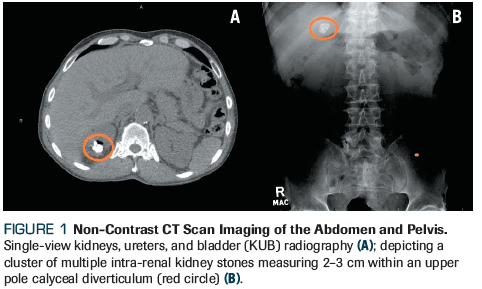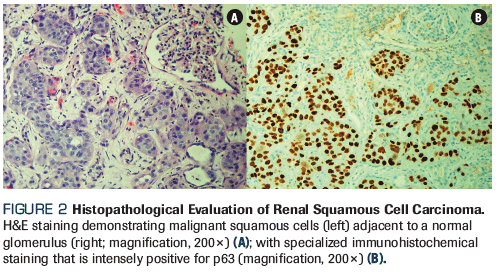Incidental Primary Squamous Cell Carcinoma of the Kidney Within a Calyceal Diverticulum Associated With Nephrolithiasis
A 64-year-old man is diagnosed with primary squamous cell carcinoma within the upper pole calyceal diverticulum of the kidney. What are the best steps of management?
Oncology (Williston Park). 33(2):69-71.

Austin Lunney, BS

Irfan Warraich, MD

Pranav Sharma, MD

Figure 1. Non-Contrast CT Scan Imaging of the Abdomen and Pelvis

Figure 2. Histopathological Evaluation of Renal Squamous Cell Carcinoma

THE CASE
A 64-year-old Hispanic man was referred to the urology clinic by his primary care physician for evaluation of right upper pole kidney stones associated with recurrent urinary tract infections (UTIs; Figure 1). The patient’s medical history was significant for well-controlled hypertension, type 2 diabetes mellitus, hyperlipidemia, and epilepsy, as well as a remote history of nephrolithiasis. In the past, he underwent several surgeries, including laparoscopic cholecystectomy, bilateral inguinal hernia repairs with mesh, and a percutaneous nephrolithotomy for a complete right staghorn renal calculus over 10 years ago, the latter of which was complicated by a pneumothorax requiring chest tube placement. The patient denied any workup or prophylaxis for stone formation. He denied any history of tobacco, alcohol, or substance abuse.
On evaluation, the patient had normal baseline renal function, with a serum creatinine level of 1.0 mg/dL. Follow-up urine cultures revealed recurrent, pan-sensitive Klebsiella pneumoniae UTIs. The patient denied any urinary complaints, and a physical examination was largely unremarkable. A follow-up CT urogram of the abdomen and pelvis with intravenous contrast was obtained, revealing a 2–3 cm cluster of renal stones within a calyceal diverticulum at the upper pole of the right kidney. Cross-sectional imaging showed no other stones and/or masses, with a normal contralateral left kidney.
After discussing potential treatment options with the patient, including the risks and benefits, a right robotic-assisted laparoscopic upper pole partial nephrectomy was selected. During the procedure, the calyceal diverticulum was extracted, and residual kidney stones were removed en bloc with renorrhaphy; the collecting system was also closed. A 1-cm margin of normal renal parenchyma was also taken deep to the calyceal diverticulum during the resection. The surgery was successful, with no postoperative complications, and the patient was discharged 2 days later.
The kidney stones were calcium oxalate monohydrate in nature. However, follow-up histopathological evaluation of the resected tissue revealed poorly differentiated carcinoma arising from the right upper pole calyceal diverticulum with invasion through the urothelial wall into the underlying renal parenchyma, with a 2–3 mm focal positive surgical margin at the base of the partial nephrectomy resection site. Microscopic examination of the tissue by our pathologist revealed keratin pearl formation, intercellular bridges, and keratotic debris, and immunohistochemical staining demonstrated strong positivity for p63 (Figure 2). Based on these findings and the patient’s clinical history, a diagnosis of primary squamous cell carcinoma (SCC) of the right kidney was established.
Given the incidental primary squamous cell carcinoma within the upper pole calyceal diverticulum of the right kidney with a positive focal surgical margin at the base of the partial nephrectomy resection site, what is the most appropriate next step in management?
A. Observation with surveillance imaging
B. Repeat right partial nephrectomy with negative histological margins
C. Salvage right radical nephrectomy
D. Adjuvant systemic therapy
E. Adjuvant radiation to the right kidney
CORRECT ANSWER: C. Salvage right radical nephrectomy
Discussion
Primary SCC of the renal pelvis and kidney is a very rare neoplasm, accounting for less than 1% of all malignant renal neoplasms.[1] SCC of the kidney occurs in men and women equally, particularly those between the ages of 50 and 70 years.[2] Most often, the etiology of SCC is long-standing nephrolithiasis, especially the formation of staghorn renal calculi.[3] The mechanism of carcinogenesis is assumed to be secondary to chronic irritation, inflammation, and/or infection, all of which can lead to squamous metaplasia. Other risk factors, such as hydronephrosis, vitamin A deficiency, chemical use, and hormonal imbalances, have also been implicated in the development of SCC of the kidney.[4,5] It is also worth noting that the incidence of renal SCC is higher in individuals with horseshoe kidneys.[6]
SCC of the kidney tends to be large, necrotic, sessile, ulcerated, and infiltrative of the renal parenchyma, as well as the perinephric soft tissue.[3] Diagnosis of this malignancy is restricted to tumors that show squamous differentiation and histological hallmarks of SCC, such as keratin pearl formation, intercellular bridges, and keratotic debris.[7] However, because most tumors are moderately or poorly differentiated, these characteristics may not be obvious.[3] Lee et al devised the classification of renal SCC as one of two groups: central or peripheral.[8] Central renal SCC is more intraluminal and is usually associated with metastases to the lymph nodes, while peripheral renal SCC is prominent in the renal parenchyma and may invade the perirenal fat before metastasizing to the lymph nodes or a distant site. Since primary SCC of the kidney is rare, it should be distinguished from metastatic SCC based on the patient’s clinical history, imaging, and histopathology.[9]
Establishing a diagnosis via imaging is difficult because SCC of the kidney exhibits no specific radiological features; in addition, given the rarity of this disease, other diagnoses, such as transitional cell/urothelial carcinoma of the renal collecting system or a complex kidney cyst, are much more likely.[10] The use of 18-fluorine fluorodeoxyglucose (18F-FDG) PET/CT imaging has been reported to be most helpful in confirming the diagnosis of these renal tumors, with a sensitivity of 62% and a specificity of 88%, although imaging cannot differentiate disease stage or grade.[11] For extra-renal SCC lesions, the sensitivity and specificity of 18F-FDG PET/CT increase to 84% and 91%, respectively, making this imaging much more useful for non-renal primary sites.[11] Overall, however, imaging is not helpful in determining the histology of primary SCC of the kidney, and diagnosis is typically made after nephrectomy.
Primary renal SCC tends to manifest at a more advanced disease stage compared with transitional cell/urothelial carcinomas and/or renal cell carcinomas, most likely due to the underlying aggressive nature of SCC, the reduced prevalence of symptoms such as hematuria or flank pain, and the lack of a measurable tumor marker in the urine or serum. Therefore, the prognosis of primary SCC of the kidney is, on average, incredibly poor, with the majority of patients presenting with locally advanced or metastatic disease and limited long-term survival.[12] Although the incidence of warning signs is low, patients may experience a constellation of symptoms, including flank or abdominal pain, hematuria, fever, weight loss, or an abdominal mass, and patients are occasionally diagnosed with localized disease incidentally.[13] Renal SCC may also be associated with paraneoplastic syndromes, such as hypercalcemia, due to the ectopic secretion of parathyroid hormone–like substances.[14]
Very little long-term data on renal SCC exist in the literature, the majority of which is contradictory. In addition, no gold standard of management exists, with many treatments being anecdotal or based on other SCC tumor sites.[12] For clinically nonmetastatic, localized primary SCC of the kidney, the best known treatment is surgical resection with radical nephrectomy (Answer C). This is because partial nephrectomy, especially in the setting of positive histological margins, is unlikely to be curative and carries a high risk of recurrence within the kidney due to the diffuse, infiltrative nature of SCC into the renal parenchyma and perinephric soft tissue (Answer B). Active surveillance with serial imaging would also not be warranted, even for smaller foci of SCC within the kidney, due to the aggressive nature of this disease and a lack of reliable imaging to accurately predict the extent of disease (Answer A).
Although surgical resection is rarely curative, adjuvant chemotherapy or radiation is usually ineffective for renal SCC (Answers D and E).[3] The most common chemotherapy agents used to treat this condition are platinum-based, with radiation most often reserved for palliative purposes in patients with metastatic disease and severe local symptoms. Currently, the combination of cisplatin, methotrexate, and bleomycin is employed for these individuals, but no benefit in survival has been observed.[4] One study reported a median survival of 7 months postoperatively, with a 5-year survival rate of 7.7%, but another demonstrated a median survival as low as 3.5 months.[3,7] In a large meta-analysis by Berz et al analyzing survival among patients with squamous cell malignancies of the upper urinary tract, the authors reported that the median overall survival time was 10 months compared with 63 months for transitional cell/urothelial histology.[12] Although the prognosis of renal SCC can be equivalent to transitional cell/urothelial carcinoma with appropriate treatment throughout each stage of disease, the average survival for primary SCC of the kidney is comparatively much worse due to more advanced disease at the time of presentation.[3]
Outcome of This Case
The patient underwent salvage right robotic-assisted laparoscopic radical nephrectomy 2 months after his initial right partial nephrectomy with calyceal diverticulectomy surgery. His postoperative course was uncomplicated, and he was discharged home on postoperative day 2. Final histopathological analysis of the remaining right kidney revealed residual pT3a primary SCC with microscopic perinephric fat invasion with negative surgical margins circumferentially and no evidence of vascular invasion. No adjuvant treatment was given.
Currently, the patient is doing well 6 months after salvage right radical nephrectomy. He has remained recurrence-free based on cross-sectional surveillance imaging with contrasted CT scan of the chest, abdomen, and pelvis at 3 and 6 months postoperatively. Periodic imaging with follow-up will be continued every 3 months for the first year.
Key Facts: Renal Squamous Cell Carcinoma
• Primary renal squamous cell carcinoma (SCC) is an extremely rare malignancy of the kidney, most often associated with long-standing nephrolithiasis, especially the formation of staghorn kidney stones, due to chronic irritation, inflammation, and/or infection, all which can lead to squamous metaplasia.
• Manifestation of primary renal SCC tends to occur at an advanced disease stage, with locally infiltrative and/or metastatic tumors that are difficult to accurately identify on imaging.
• The prognosis of renal SCC is poor, with an average median survival of less than 1 year. No proven survival benefit has been seen with the use of adjuvant chemotherapy or radiation treatment after surgical resection.
Financial Disclosure: The authors have no significant financial interest in or other relationship with the manufacturer of any product or provider of any service mentioned in this article.
References:
1. Li MK, Cheung WL. Squamous cell carcinoma of the renal pelvis. J Urol. 1987;138:269-71.
2. Holmäng S, Lele SM, Johansson SL. Squamous cell carcinoma of the renal pelvis and ureter: incidence, symptoms, treatment and outcome. J Urol. 2007;178:51-6.
3. Bhaijee F. Squamous cell carcinoma of the renal pelvis. Ann Diagn Pathol. 2012;16:124-7.
4. Attalla K, Haines K, Labow D, et al. Squamous cell carcinoma of the renal pelvis: atypical presentation of a rare malignancy. Urol Case Rep. 2017;13:137-9.
5. Tyagi N, Sharma S, Tyagi SP, et al. A histomorphologic and ultrastructural study of the malignant tumours of the renal pelvis. J Postgrad Med. 1993;39:197-201.
6. Mizusawa H, Komiyama I, Ueno Y, et al. Squamous cell carcinoma in the renal pelvis of a horseshoe kidney. Int J Urol. 2004;11:782-4.
7. Bandyopadhyay R, Biswas S, Nag D, et al. Squamous cell carcinoma of the renal pelvis presenting as hydronephrosis. J Cancer Res Ther. 2010;6:537-9.
8. Lee TY, Ko SF, Wan YL, et al. Renal squamous cell carcinoma: CT findings and clinical significance. Abdom Imaging. 1998;23:203-8.
9. Ghosh P, Saha K. Primary intraparenchymal squamous cell carcinoma of the kidney: a rare and unique entity. Case Rep Pathol. 2014;2014:256813.
10. Kumar S, Tomar V, Yadav SS, et al. Primary squamous cell carcinoma of kidney associated with large calculus in non-functioning kidney: a case report. Urol Case Rep. 2016;8:4-6.
11. Wang Z, Yan B, Wei YB, et al. Primary kidney parenchyma squamous cell carcinoma mimicking xanthogranulomatous pyelonephritis: a case report. Oncol Lett. 2016;11:2179-81.
12. Berz D, Rizack T, Weitzen S, et al. Survival of patients with squamous cell malignancies of the upper urinary tract. Clin Med Insights Oncol. 2012;6:11-8.
13. Jiang P, Wang C, Chen S, et al. Primary renal squamous cell carcinoma mimicking the renal cyst: a case report and review of the recent literature. BMC Urol. 2015;15:69.
14. Diaz González R, Barrientos A, Larrodera L, et al. Squamous cell carcinoma of the renal pelvis associated with hypercalcemia and the presence of parathyroid hormone-like substances in the tumor. J Urol. 1985;133:1029-30.
